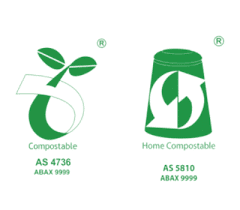
Council websites and bin audit data¹⁻³ indicate that Australian households generate an average of 1000 to 1200 kilograms of domestic kerbside waste per year, and approximately 50% of that is food waste. Without a food and organics composting solution, food waste goes to landfill, taking up space and contributing to greenhouse gas emissions. With a food and organics separation solution, food and organics can be made into compost to be used by farmers and growers, creating a circular economy.
Bill Grant, agricultural and environmental scientist with extensive experience in organic resource recovery, says that focussing on having a system to separate your food and organics, recyclables and other waste within the home can make a huge difference and reduce what you send to landfill by half.
“Separating food and organics using certified compostable caddy liners and education around how much food can be diverted via FOGO services can have a huge impact. From my research, nearly all of the councils that have achieved the highest ongoing high rates of household participation and food recovery have used certified compostable caddy liners,” said Mr Grant.
“Caddy liners reduce the ‘yuck’ factor for many households, making food waste easier to handle and less messy in FOGO bins. This means more people use the services available to divert food waste from the general waste bin. To maximise food waste recovery, certified compostable caddy liners should be used, as they will fully biodegrade during the initial 4-6 weeks of a well-run commercial composting process.”
Top tips for households to separate food waste organics and divert this from landfill, according to the Australasian Bioplastics Association
STEP 1: Check bin and waste disposal options available in the local area.
Local council websites provide information on the types of bins available in each area, as well as what is acceptable to place in those bins. For example, Penrith City Council, City of Sydney website and Sutherland Shire have easy-to-access guidelines available online. Penrith City Council was the first metropolitan council in Australia to introduce the FOGO (Food Organics Garden Organics) bin in 2009 and has composted more than 400,000 tonnes of FOGO waste since it began, relieving pressure on local landfill.
Bins are colour coded for plant matter, recycling, general waste, paper recycling and food and organics, varying from council to council. 164 councils in Australia offer FOGO (Food Organics and Garden Organic) collection services and by 2030, all NSW councils have been mandated to introduce the FOGO bin. It allows residents to separate food scraps and organics from other waste, to be made into compost and then returned for use to the farming community.
STEP 2: Set up a good system.
Having a streamlined system to separate food and organics as they are generated can help avoid contamination, ensuring items end up in the right bin for collection. A good way to do this is to have smaller versions of the bigger bins in or near the kitchen, so items can easily be sorted and moved to the correct place for kerbside collection.
The following system works for residents with a FOGO bin:
a) Small bin for recycling bin for bottles, cans. Remember to check for the Australasian Recycling Label (ARL) when disposing of packaging in the yellow bin to make sure bottles and containers can be recovered for future use. If you’d like to get some money back for these recycling efforts, in NSW you can search for the nearest ‘return and earn’ point to recycle your eligible containers and get a 10c refund. The Planet Ark ‘Check it before you chuck it’ website provides helpful information on how to check food packaging bottles and containers before you put it in the right bin.
b) A small bin in a cool place, out of sunlight, near where you prepare food, to place food and organic waste for the FOGO bin. If you use a smaller bin lined with a certified composted caddy liner and clear it into the larger FOGO bin each day, this can avoid anything starting to smell.
c) Paper bin for anything paper or cardboard. Some cardboard products can be certified compostable as well, so keep an eye out for the seeding logo to check if it can go into the FOGO bin.
d) General waste bin for anything unrecoverable and plastics.
Not every council currently has a FOGO bin, however state governments have mandates in place for the collection of source-separated food organics and garden organics (FOGO) waste in the future. The Australian Packaging Covenant Organisation (APCO) National Packaging targets include 100% reusable, recyclable or compostable packaging by 2025.
STEP 3: Be sure to use certified compostable caddy liners.
It’s important to check what packaging materials are made of, including bin or caddy liners. Certified compostable products are suitable for commercial composting facilities are visually identified by the seedling logo. The logo symbolises that the manufacturer’s or suppliers’ claims that the products have met all of the requirements of the Australian Standard 4736 have been verified.
To divert food waste organics from landfill , look for the seedling logo when buying certified compostable caddy liners and look for the home compostable logo (AS5810) when home composting. By starting in the home and having good systems in place to ensure waste goes to the right place, it’s possible to lower environmental impact and make a difference.
Learn more about the Australasian Bioplastics Association
References
2. https://www.kyogle.nsw.gov.au/wp-content/uploads/2024/11/Kyogle-Council-3-Bin-Waste-Audit-2024.pdf
3. Domestic kerbside residual waste in NSW – Results of the 2011 – 2019 audits(March 2020)